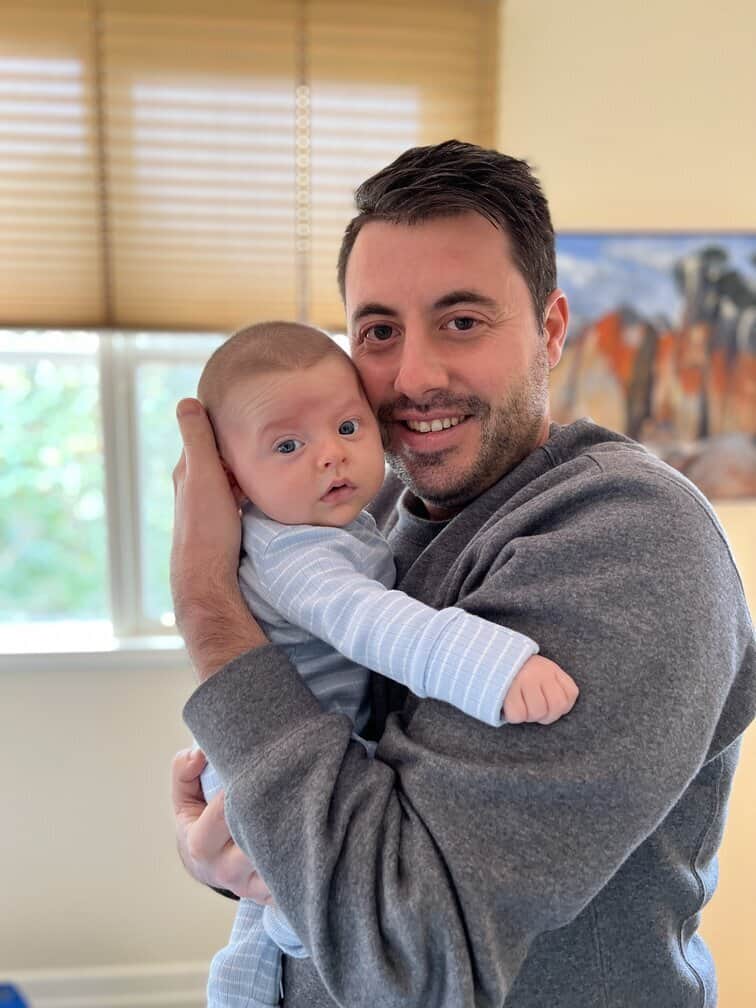As a new dad to a 4-month-old baby, I have very recent experience with the 3-month sleep regression. When your baby is settled and in a nice routine, it can feel like a real blow when everything seems to change overnight during a sleep regression.
We’ve survived the 3-month sleep regression, and you will too. In this piece, we’ll have 3 month sleep regression explained and everything you need to know about this difficult but also exciting stage of life with your baby.
What is the 3-month sleep regression?
The 3-month sleep regression makes more sense when you understand what is happening biologically. According to the book ‘The Wonder Weeks’, babies begin to learn about smooth transitions at week 12.
What does that mean? You might notice that your baby will start to move differently, with their movements becoming more fluid, as opposed to sudden jerky movements. Your baby will start to awaken to the world around them, and you may notice them becoming more absorbed by things they can see.
While this is exciting for everyone, it’s also a little unsettling for babies, who may turn to their main carers for comfort more often.
So, why does this disturb sleep? Because it coincides with your baby’s sleep schedule changing. They will want to transition to sleeping less frequently in the day, but unfortunately, this can become a little chaotic, at least to begin with. Plus, as your baby begins to change, he or she will want more comfort from you, which may make it more difficult to get them to settle down on their own.
Interesting Read: What Exactly is a Sleep Regression?
How To Tell If your Baby Is Experiencing The 3-Month Sleep Regression
There are a few signs, including:
- Becoming shyer with strangers: Babies might start to show a distinct preference for their main carers at this stage.
- Sleeping poorly at night: An obvious sign, you may notice your baby waking up more frequently and finding it hard to settle back down to sleep.
- A chaotic nap schedule: If your baby sleeps for hours one afternoon and then refuses to sleep at all the next afternoon, chances are they’re going through the 3-month sleep regression. You may also notice nap times becoming shorter as a general pattern.
- Seeking comfort: Babies find this stage unsettling, so they might suck their thumb more often and may cry for cuddles a lot.
Hints and tips for navigating the 3-month sleep regression
The 3-month sleep regression is a shock to most parents. Many babies sleep pretty well in the early days, but the 3-month age can start to cause problems.
There are a few things you can do to help make this period a little easier.
Acknowledge your Feelings
This sounds like a strange first step, but it’s important. Dealing with a baby crying for hours in the night may prompt some difficult feelings, including frustration and sadness. You might feel anxious, and you may feel intense pressure to get ‘back to normal’.
Recognize these feelings and make a mental note of them. It’s important to seek help if you start to feel overwhelmed. That could be asking a grandparent to babysit at the weekend so you can sleep or speaking to a doctor about mental health support.
It’s also a good idea to keep an eye on your spouse and to check in with each other from time to time.
Observe Their Sleep Pattern
Over a few days, log your babies’ sleep schedule (you can use an app like Huckleberry to make this easier). You might be able to spot a pattern forming: for example, they might seem to need less sleep in the afternoons, or they might be developing a preference for shorter naps.
Babies at 3 months old still need a lot of sleep. Ideally, they should have between 3-5 naps, and they shouldn’t be awake for more than 2.5 hours at a time if possible.
Watch Out for Tired Cues
Look out for your babies’ sleep cues. They might start crying and fussing, yawning, rubbing their eyes, or becoming a little unfocused. Catching these cues can help you to put them down for a nap quickly, rather than allowing them to become overtired (which can make putting them down for a nap more difficult).
Start to Introduce a Bedtime Routine
If you haven’t already, now is the perfect time to introduce a bedtime routine. The earlier you can put this in place, the better. Routines help babies to understand that nighttime is coming, which can help them to sleep better.
Good bedtime routines can include:
- A bath
- Dimming the lights
- Speaking more quietly
- Gentle, calming lullabies
- A bedtime story
- A gentle massage (you can use baby massage oil after a bath for the most relaxing results)
- Slowly dress them in layers to keep them warm at night, speaking softly and slowly as you do so
Try White Noise
White noise can help unsettled babies. There are many white noise apps out there, or you can buy a soft toy with white noise built into it.
You can also check out our guide to the best baby sleep products for more ideas, including recommendations for a white noise machine.
Enjoy Exploring their New Skills
Babies will enjoy having their new skills put to the test at this stage. Make sure you take time to explore the world with them in the daytime. Now is a great time to create a sensory basket. To do this, take a basket and fill it with interesting objects. Crinkly paper, bumpy fabric, and household objects can work well here. Allow your baby to explore these objects for as long as they want.
Just make sure you observe them as they play to keep them safe and don’t allow them to access small objects that they may choke on.
You can also buy books and toys with different textures to achieve the same thing. Books for babies are ideal at this age, especially those with high-contrast images.
Babies also enjoy trying to move at this stage. Let them have some diaper-free time, so they have more freedom to wiggle around.
Make the Transition Easier
Some parents prefer to cuddle or feed their babies to sleep. Even parents who prefer to allow their babies to settle themselves may find that their baby just won’t go to sleep without being held at the 3-month stage.
The key to the ‘cot handover’ is to try to make the transition as smooth as possible. You can do this by making the cot or Moses basket as warm as possible (using a hot water bottle – just remember to remove it a few moments before you put the baby in there, as it will be too hot to start with).
Your baby may also appreciate a heartbeat sound. You can download an app for this or buy a stuffed toy with a heartbeat sound built-in (like the Lulla Bear Shusher, for example).
Hold Steady
You can’t fast-forward this stage, unfortunately, and it can be so tough to try to live a normal life when you’re sleep-deprived. The key is to just bear in mind that this stage will pass.
In the meantime, it may be helpful to lower your expectations. Don’t force yourself to keep the house tidy or stay on top of the laundry. Consider asking friends or family to cook meals for you, or just rely on takeout a couple of nights a week to make things easier.
It may also help to stop recording sleep times. If you find that you are obsessing over how much sleep your baby has had, it may be time to stop watching it so closely. Sometimes, obsessing over numbers can make your mental state worse. Instead, just try to get whatever sleep you can, and don’t be afraid to ask friends or family to help.
It’s completely normal for babies to be unsettled at night. Don’t compare your baby to others (even though this is difficult to do). Just because your baby seems to sleep worse than others, doesn’t mean that will be the case forever.
How to Do Sleep Training During The 3-Month Sleep Regression
If you’re sleep training, the 3-month sleep regression can cause complications. In my opinion, it’s best not to try to force your baby into a schedule while they’re in the middle of a sleep regression. They will be feeling unsettled for a reason, and it may cause unnecessary strain on you (and your whole family) to try to make them sleep when they just can’t.
Don’t worry, though. You’ll be able to restart sleep training after the sleep regression is over, and your baby won’t be harmed by temporarily pausing the routine.
You can keep certain principles in place, too. The bedtime routine is really important, even when your baby is very unsettled. Consistency is key in helping your baby to wind down at nighttime. It will help to keep this routine in place, even if it feels like it’s not working out right now.
Frequently asked questions
Here are some questions you may have about the 3-month sleep regression:
Question: How can I cope with a super clingy baby?
Answer: This is so tough! It can feel hard to get anything done when you have a clingy baby. Even showering or eating can feel like a huge challenge.
My key advice would be to think about buying a sling or a baby carrier. When my baby is clingy, I put them in the sling and carry them around the house. This allows us to get some jobs done, and the baby feels safe cuddled up next to me. (You can read our thoughts on the best baby carriers for doing chores around the house for some recommendations.)
Question: Is it okay to leave my baby to cry for a few minutes?
Answer: Yes. It’s helpful to remind yourself that babies can cry for a few moments without coming to any harm. Sometimes your needs are greater, and your baby will be okay if you strap them safely in a bouncer and leave them to use the bathroom/grab a snack/take a quick moment to breathe.
Question: Do growth spurts cause sleep problems?
Answer: Yes. Growth spurts can cause sleep problems. You may be able to tell if your baby is about to grow because chances are they will want to feed more often. This means they might start waking more at night. If your baby seems hungry all the time, they’re probably about to grow.
3-month Sleep Regression: The Key Takeaways
The key things to remember are:
- A 3-month sleep regression is normal
- It is also normal for your baby to be more clingy at this stage
- Keep the bedtime routine in place, but scrap the sleep training for now
- Don’t be afraid to ask for help when you need it, and keep an eye on your mental health
- Remember: this too shall pass!
Always contact your pediatrician if you’re worried about anything. I hope this has helped you to get through the 3-month sleep regression. I know how hard it is, but it will pass by before you know it.
Keep reading to find out more about the 4-month sleep regression to prepare yourself for the next stage.
As a new dad himself, David understands the struggles in dealing with a newborn’s sleep schedule. He knows how hard it is to work and deal with a lack of sleep at night. He thoroughly tests out products and can advise which are best for your little one. In his spare time, he enjoys riding ATVs and BMX.




